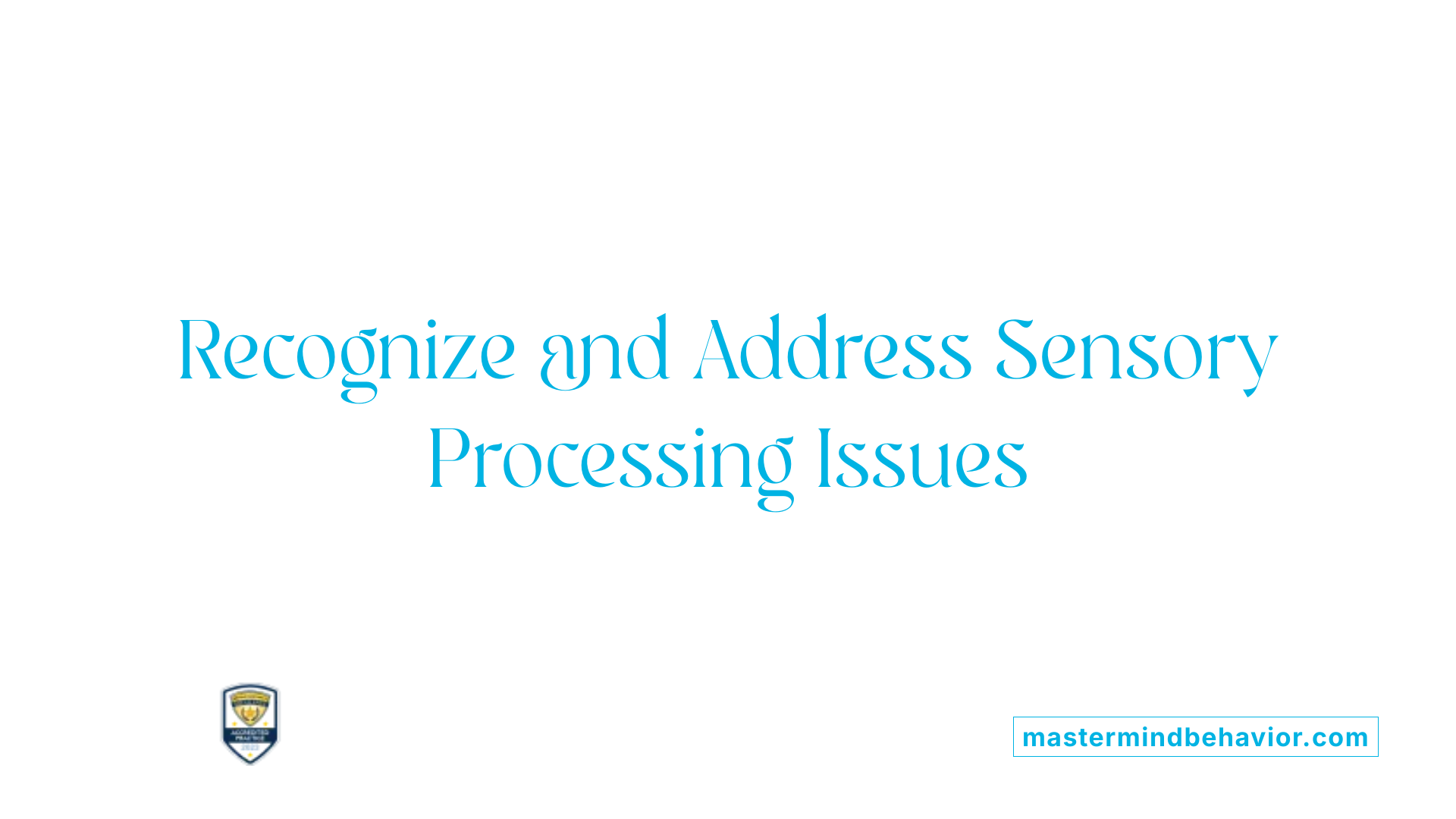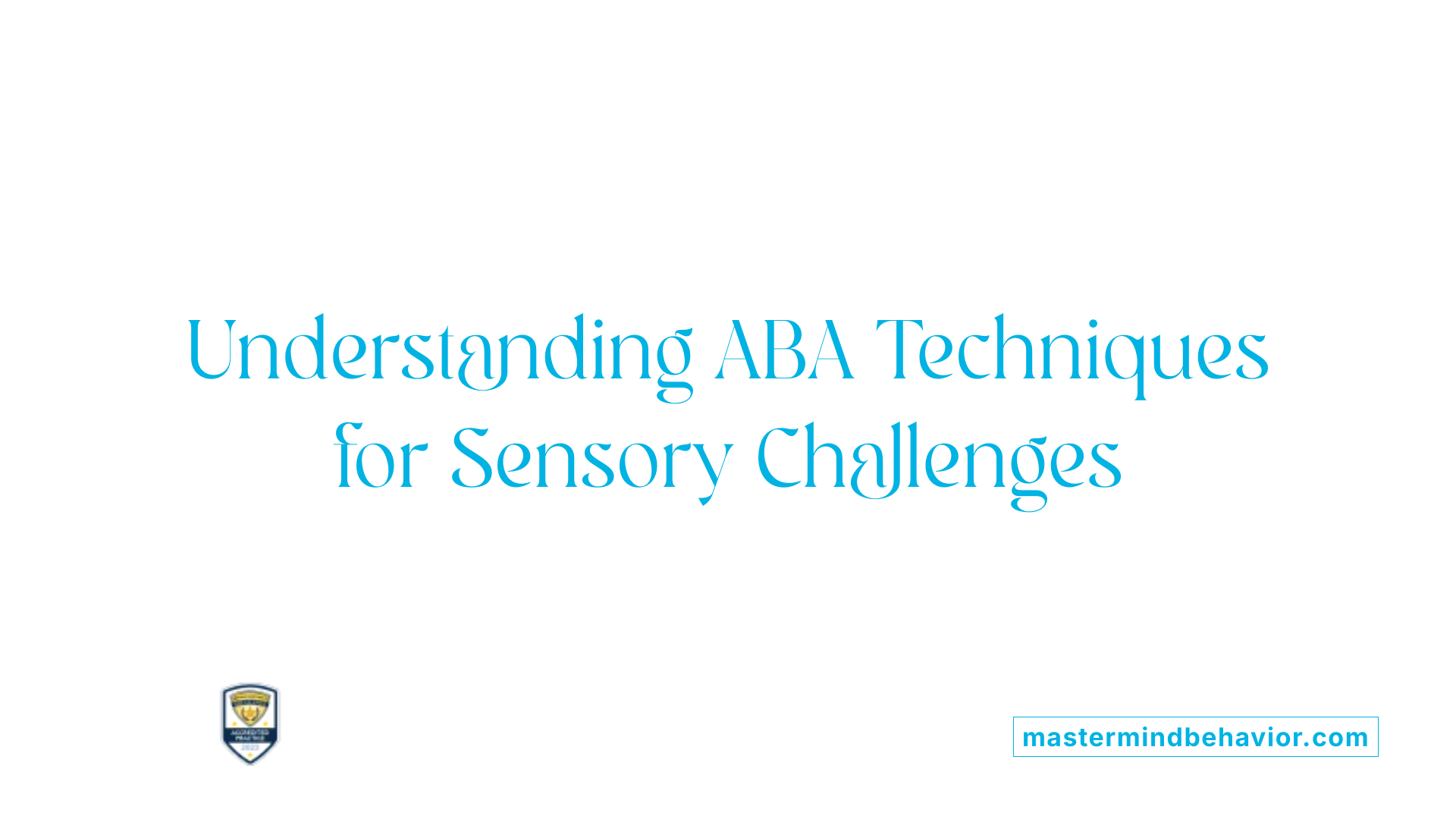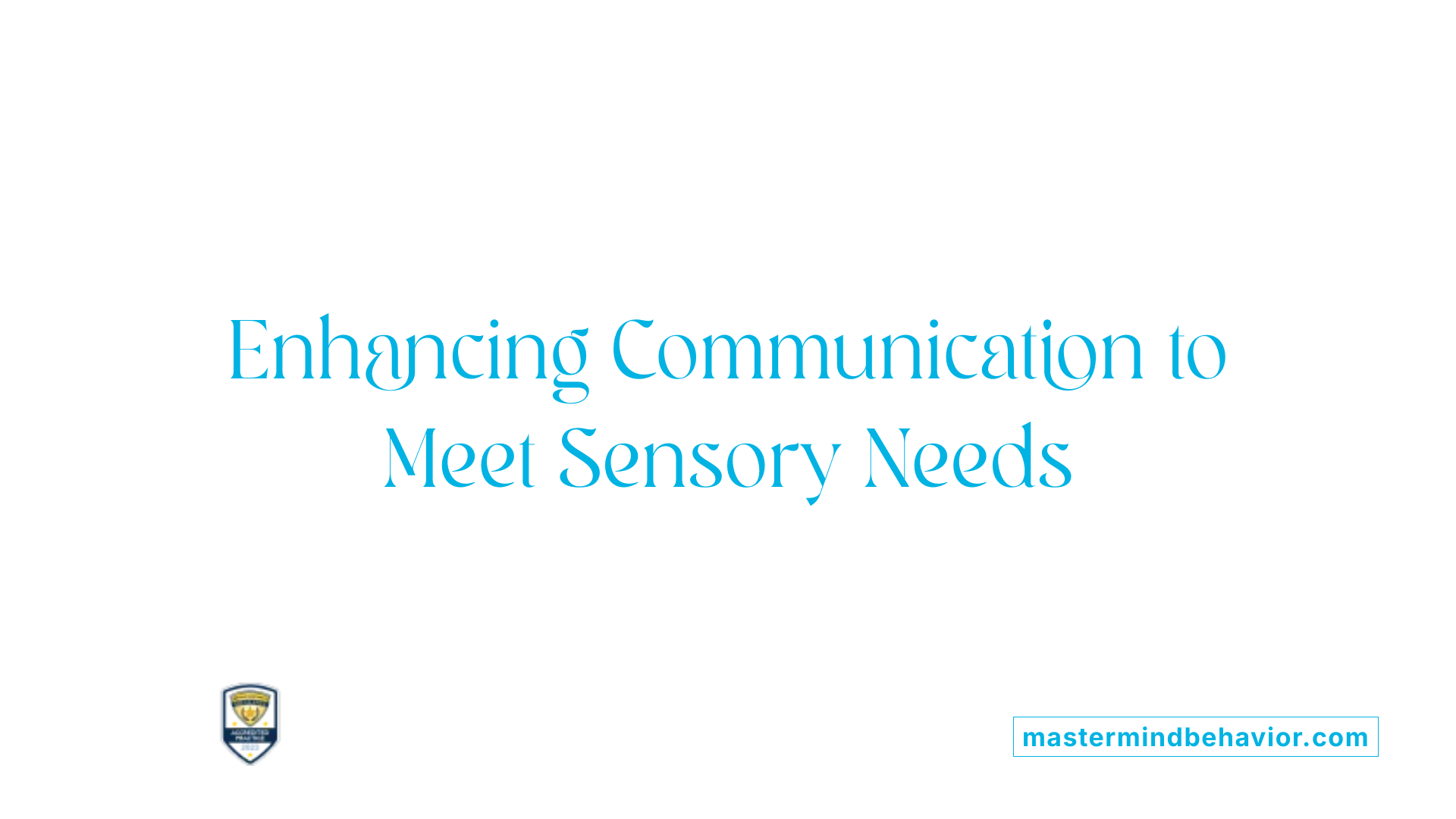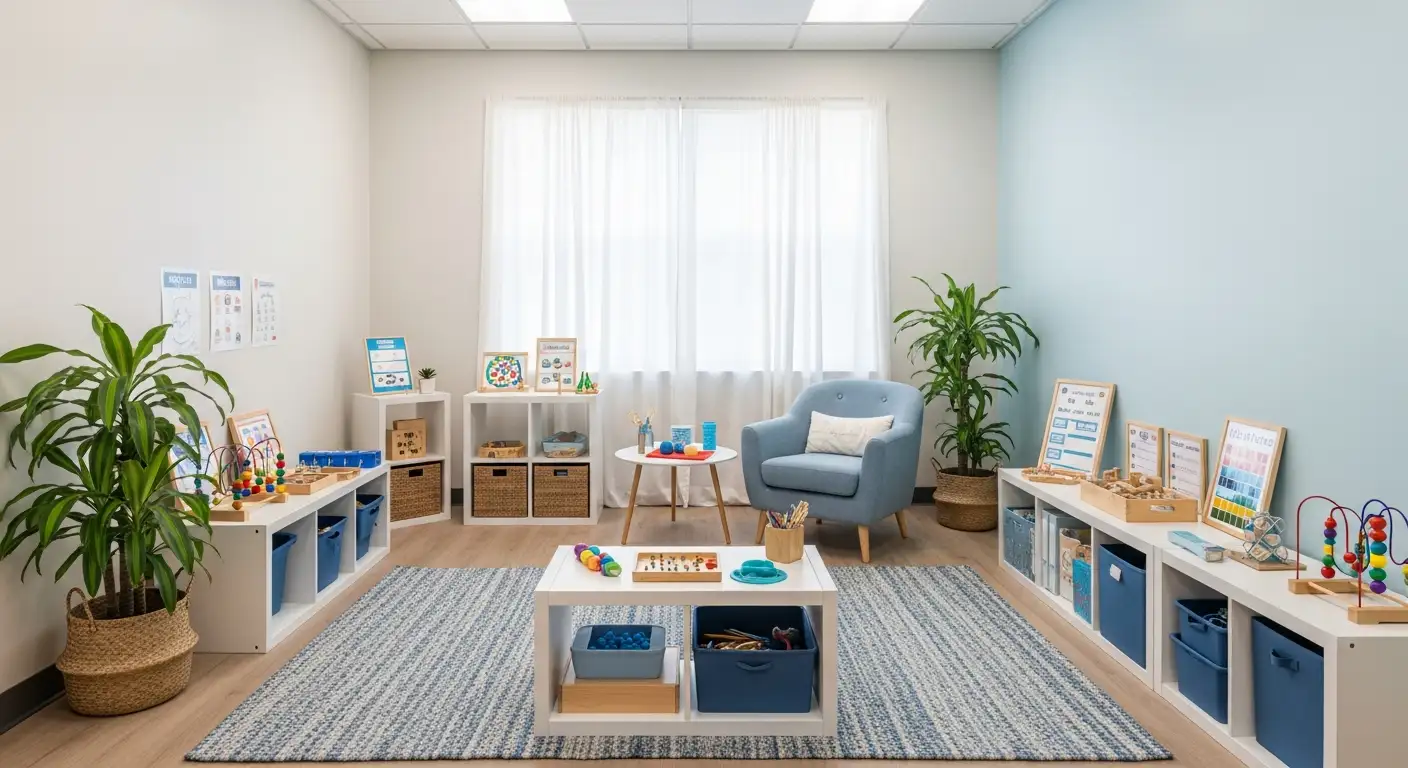Introduction to ABA and Sensory Challenges
Applied Behavior Analysis (ABA) therapy stands as a scientifically supported intervention designed to help individuals with autism spectrum disorder (ASD) improve a broad range of skills, including sensory tolerance. Sensory processing difficulties, common among children with ASD, can result in discomfort, anxiety, and behavioral challenges when navigating sensory-rich environments. This article explores how ABA therapy not only enhances communication and social skills but also significantly improves tolerance to everyday sensory experiences, leading to better overall functioning and quality of life.
Understanding ABA Therapy: Foundations and Applications

What is Applied Behavior Analysis (ABA) therapy and how is it used in treating autism?
Applied Behavior Analysis (ABA) therapy is an evidence-based approach grounded in the scientific study of behavior. It focuses on encouraging positive behaviors and teaching new skills to individuals with autism spectrum disorder (ASD). ABA analyzes how environmental factors influence behavior and applies techniques such as positive reinforcement to help children learn important communication, social, and self-care skills.
The scientific basis and historical context of ABA
Developed in the 1960s by Ole Ivar Lovaas and influenced by behaviorist principles from Sidney Bijou and B.F. Skinner, ABA has evolved from early, more rigid methods to include naturalistic and play-based models today. It is backed by decades of rigorous research and recognized by organizations like the U.S. Surgeon General for its effectiveness in improving cognitive, social, and adaptive skills in children with autism.
Techniques employed in ABA therapy
ABA therapy employs a variety of activities to teach skills and reduce problematic behaviors. These include:
- Playing in language-rich environments to develop communication skills
- Role-playing and pretend play to enhance social understanding
- Matching games and puzzles to improve focus, memory, and problem-solving
- Sensory integration activities to build tolerance to different sensations
- Singing songs and storytelling to reinforce concepts and social cues
These activities are tailored to each child’s unique needs through individualized treatment plans created and supervised by certified professionals such as Board Certified Behavior Analysts (BCBAs).
The role of ABA in autism treatment
ABA is the gold-standard intervention for ASD, offering targeted strategies to increase desirable behaviors and decrease harmful or disruptive ones. Early intensive ABA programs, ideally starting before age 4 and delivered over 20 hours weekly, have shown significant developmental gains. Therapy can take place in home, school, or community settings, incorporating family involvement to maximize success. ABA also supports children with sensory processing challenges by teaching coping skills and improving sensory integration.
Overall, ABA therapy is a scientifically supported, personalized, and comprehensive approach that empowers children with autism to improve communication, social skills, and daily functioning.
Sensory Processing Challenges in Autism

What is sensory processing
Sensory processing refers to the nervous system’s ability to manage and respond to sensory information from the environment. This includes processing inputs such as touch, sound, sight, taste, and movement. For many children with autism spectrum disorder (ASD), sensory processing can be particularly challenging. The brain might have difficulty organizing these sensory signals properly, leading to over- or under-responsiveness.
How sensory processing difficulties affect children with autism
Children with autism who have sensory processing difficulties often struggle to make sense of their surroundings. This can interfere with their ability to engage in daily activities or social interactions. Sensory processing disorder (SPD) in autism can manifest as hypersensitivity to textures, sounds, or lights, or less commonly, as diminished responsiveness. These difficulties can undermine learning and participation.
Behavioral manifestations of sensory overload
When sensory input becomes overwhelming, children with autism may exhibit various behaviors to cope. These can include withdrawal, irritability, aggression, self-injurious behaviors, or repetitive motions such as rocking or hand-flapping known as stimming. Such behaviors act as mechanisms to manage or communicate discomfort or anxiety caused by sensory overload.
Sensory-related anxiety and discomfort
Sensory processing issues often generate significant anxiety and discomfort for the child. Sensory-rich settings such as crowded rooms, noisy environments, or unexpected tactile experiences can provoke distress. This heightened anxiety affects their emotional well-being and may lead to avoidance of certain environments or social situations.
Understanding these challenges is crucial for creating effective interventions that help children with autism better tolerate sensory input, reduce anxiety, and improve their ability to function comfortably in various settings.
How ABA Therapy Addresses Sensory Sensitivities

Use of Sensory Integration Techniques
ABA therapy incorporates sensory integration techniques to help children with sensory processing disorder (SPD) better manage their reactions to sensory stimuli. By carefully structured activities such as sensory bins, children are encouraged to explore different textures, temperatures, and sensations in a controlled and supportive environment. This approach fosters sensory tolerance and builds confidence in sensory-rich settings.
Role of Positive Reinforcement
Positive reinforcement is a cornerstone of ABA therapy strategies aimed at improving sensory sensitivities. By rewarding children when they successfully tolerate or engage with challenging sensory inputs, therapists encourage repeated engagement and gradual improvement. This reinforcement helps develop coping mechanisms and promotes adaptive behaviors related to sensory experiences.
Gradual Desensitization Strategies
A critical element of ABA in managing sensory sensitivities involves gradual desensitization. This technique exposes children slowly and systematically to sensory inputs that initially may cause discomfort or anxiety. Over time, this process reduces hypersensitivities, enabling the child to respond more calmly and appropriately to sensory stimuli in daily life.
Use of Sensory Breaks
ABA therapy also integrates sensory breaks as a strategy to manage sensory overload. These breaks allow children to withdraw temporarily from overwhelming environments, helping them regulate their sensory input and reduce behavioral reactions. When combined with targeted interventions, sensory breaks support sustained participation in educational and social activities.
Together, these strategies create a comprehensive ABA approach that supports children with sensory sensitivities to better understand, tolerate, and manage sensory stimuli. This ultimately improves their ability to engage comfortably in everyday situations and enhances their overall quality of life.
ABA Therapy Activities Targeting Sensory Tolerance
Sensory bins and their role
Sensory bins are a common ABA therapy activity that helps children with autism explore and tolerate different textures, temperatures, and sensations. By encouraging hands-on interaction in a controlled way, sensory bins promote sensory integration and build confidence in children who may otherwise find sensory experiences overwhelming.
Playing in language-rich environments
Engaging children in play within language-rich environments enhances their communication and language skills. This approach also fosters a positive and stimulating learning atmosphere, which can help children feel more comfortable and open to sensory inputs during their therapy sessions.
Role-playing to simulate real-world sensory scenarios
Role-playing and pretend play are valuable techniques in ABA therapy to prepare children for real-life sensory situations. By simulating everyday experiences, these activities help children develop social skills while gradually exposing them to sensory scenarios they might encounter outside therapy.
Use of matching games and puzzles for sensory exposure
Matching games contribute to improving focus, pattern recognition, and visual processing, all while introducing sensory elements in a fun context. Puzzles similarly enhance fine motor skills and hand-eye coordination, allowing children to engage with sensory input through problem-solving tasks. Both activities support sensory development and help children manage sensory information effectively.
Professional Team Behind ABA Therapy Delivery
Roles of Board Certified Behavior Analysts (BCBAs)
Board Certified Behavior Analysts are highly trained professionals who design and oversee ABA treatment plans. They analyze each child's behavior, identify interventions, and ensure that therapy goals align with the child's unique needs. BCBAs also train and supervise other staff members to maintain the quality and effectiveness of therapy.
Registered Behavior Technicians (RBTs) and Their Duties
Registered Behavior Technicians are paraprofessionals who work directly with children to implement the ABA interventions designed by BCBAs. They carry out daily therapy sessions, collect data on the child's progress, and provide the one-on-one support essential to personalized care. RBTs must work under the close supervision of a BCBA to ensure intervention fidelity.
Qualifications and Certifications Required
BCBAs typically hold graduate-level degrees in behavior analysis or related fields. They complete rigorous supervised fieldwork and pass an extensive certification exam. Many are licensed by state boards and must adhere to ethical standards and continuing education requirements. RBTs obtain certification by completing specialized training programs, passing competency assessments, and receiving ongoing supervision from BCBAs.
Importance of Monitoring and Fidelity
To ensure successful outcomes, continuous data collection and intervention adjustments are crucial. BCBAs routinely monitor therapy sessions and oversee RBTs to maintain treatment fidelity. This means ABA interventions are implemented as intended, which is vital for the effectiveness of therapy and achievement of targeted goals.
| Role | Certification/Qualification | Primary Responsibilities |
|---|---|---|
| Board Certified Behavior Analyst (BCBA) | Graduate degree, supervised fieldwork, certification exam passed | Designs treatment plans, supervises therapy, trains staff, evaluates progress |
| Registered Behavior Technician (RBT) | Certification program, competency exam, supervised practice | Implements ABA interventions, collects data, provides direct therapy under BCBA oversight |
This multidisciplinary professional team works collaboratively to deliver evidence-based ABA therapy tailored to each individual's needs.
Differentiating ABA from Other Autism Therapies
How does ABA therapy differ from other therapies used for autism treatment?
ABA therapy stands out from other autism interventions due to its reliance on evidence-based, data-driven methods focused on modifying specific behaviors. This therapy uses structured techniques such as discrete trial training and pivotal response training to systematically teach desirable skills and reduce inappropriate behaviors. The precision of these interventions allows for continuous monitoring and adjustment based on measurable progress.
Unlike developmental therapies—which emphasize emotional growth, sensory experiences, and social play to build foundational skills—ABA focuses on achieving concrete, goal-oriented outcomes. It targets skills across multiple areas including communication, social interaction, academic abilities, and daily living tasks.
ABA’s versatility extends beyond autism, addressing behavioral challenges in conditions such as ADHD, OCD, PTSD, and traumatic brain injury. This adaptability highlights its broad application in behavioral health.
A hallmark of ABA is the comprehensive involvement of caregivers, who are trained to apply strategies consistently across diverse settings. Therapy sessions occur in natural environments like homes, schools, and community spaces, aiding the generalization of learned skills. This caregiver partnership ensures that interventions are personalized and effectively integrated into the child’s daily life.
In summary, ABA differs from other autism therapies through its structured, science-based approach; its emphasis on measurable improvements; and its flexible implementation in various settings with active family participation.
Early Intervention: Maximizing Sensory Integration Outcomes
Why Is Early and Intensive ABA Therapy Important?
Early intervention with Applied Behavior Analysis (ABA) is critical for maximizing developmental progress, especially in sensory integration and processing. Initiating therapy before age 4 and providing more than 20 hours per week has been linked to significant developmental gains, enhancing communication, social, and daily living skills. ABA identifies sensory overload causes and applies strategies like gradual desensitization and sensory breaks to improve a child's tolerance to sensory inputs.
What Developmental Gains Can Early Treatment Provide?
Children receiving intensive ABA therapy early often show improved language and social skills, better emotional recognition, and reduced behavioral challenges. These advances enable greater participation in typical environments like home and school. Early treatment can also develop functional and academic skills, setting a foundation for lifelong learning and independence.
How Does Early Intervention Reduce the Need for Additional Services?
By addressing sensory processing difficulties and associated behaviors promptly, ABA therapy can reduce the demand for supplementary therapies and complex interventions later. The improvement in coping mechanisms and skill acquisition lowers overall service dependency, making early ABA both effective and efficient.
What Are Naturalistic and Play-Based ABA Models?
Modern ABA has evolved towards naturalistic, play-centered approaches such as pivotal response training and the Early Start Denver Model. These methods embed learning into enjoyable play and everyday activities, enhancing engagement and generalization of skills. This linkage to real-world contexts supports smoother sensory integration and social development.
| Aspect | Description | Benefit |
|---|---|---|
| Early Intensive ABA | Over 20 hours per week of ABA starting before age 4 | Promotes major developmental and sensory processing improvements early on |
| Developmental Gains | Better communication, social, cognitive, and motor skills | Enhances participation in daily life and education |
| Reduction of Services | Less need for additional therapies and complex interventions | Cost-effective and sustainable treatment approach |
| Naturalistic Models | Play-based, embedded learning through methods like PRT and ESDM | Increased motivation, enjoyment, and real-life application of skills |
Role of Positive Reinforcement in Sensory Tolerance

How Positive Reinforcement Shapes Behavior
Positive reinforcement is a foundational technique in ABA therapy, used to encourage desired behaviors by rewarding them. When children with sensory sensitivities receive positive feedback for tolerating uncomfortable sensations or responding calmly during sensory challenges, they learn to associate these situations with positive outcomes. This process gradually increases their willingness to engage with sensory stimuli that might otherwise cause distress.
Building Coping Mechanisms for Sensory Sensitivities
ABA therapy uses positive reinforcement to not only increase tolerance but also to develop coping mechanisms. For instance, therapists might reinforce a child's ability to request a sensory break or use calming strategies when overwhelmed. Such reinforcement helps children adopt adaptive responses, empowering them to manage sensory overload more effectively in daily life.
Examples of Reinforcement in Sensory Tolerance Development
Practical applications include praising a child for touching new textures in sensory bins or successfully completing a matching game involving sensory components. Each time a child demonstrates increased tolerance or appropriate reactions, they might receive verbal praise, tokens, or small rewards. These reinforcements encourage repetition and mastery of sensory integration skills, ultimately promoting greater independence and comfort in sensory-rich environments.
Improving Communication to Support Sensory Needs

Teaching social cues and non-verbal communication
ABA therapy plays a crucial role in teaching children with autism how to recognize and use social cues and non-verbal communication. Through structured techniques like role-playing and video modeling, children learn to interpret facial expressions, body language, and gestures. This improved understanding aids them in engaging more comfortably and effectively with others in social settings.
Expressing sensory needs through communication
Many children with sensory sensitivities struggle to communicate their discomfort or needs related to sensory input. ABA therapy helps by teaching these children to express their sensory experiences verbally or through alternative communication methods. Techniques involve reinforcing language that describes sensations and providing tools to request breaks or adjustments, which empowers children to advocate for themselves and reduces anxiety and frustration.
Role-playing and social stories in enhancing communication
Using role-playing and social stories, ABA therapy simulates real-life scenarios that children might encounter. This method allows them to practice appropriate responses, conversational skills, and self-advocacy in a safe environment. These strategies build both verbal and non-verbal communication abilities, making it easier for children to navigate social interactions and sensory challenges in daily life.
These communication improvements are vital as they support children’s ability to manage sensory overload better, express their needs, and foster meaningful social connections, ultimately enhancing their quality of life.
Customizing ABA Treatment for Sensory Challenges
How Are Individualized Treatment Plans Developed?
ABA therapy begins with a comprehensive analysis by board-certified behavior analysts (BCBAs), who identify the specific sensory challenges affecting each child. This assessment helps determine triggers for sensory overload and guides the development of tailored interventions to improve sensory processing and reduce behavioral difficulties.
What Sensory Integration Techniques Are Used?
Sensory integration within ABA addresses a child’s unique reactions to textures, sounds, and other stimuli. Techniques include sensory bins to encourage exploration, gradual desensitization approaches to build tolerance, and sensory breaks that help children manage overstimulation calmly. These strategies promote confidence and better participation in daily activities.
How Do Families Collaborate in the Process?
Family involvement is crucial in customizing ABA treatment. Therapists work closely with caregivers to understand a child’s sensory environment and challenges at home and in the community. This partnership ensures consistency across settings and empowers families to reinforce coping skills and positive behaviors.
What Are Examples of Personalized Sensory Interventions?
- Playing in language-rich environments fosters communication within engaging sensory scenarios.
- Role-playing scripts real-life situations, improving social skills alongside sensory comfort.
- Using puzzles and matching games that integrate sensory and cognitive exercises.
- Singing songs to support auditory processing and attention.
At All Star ABA and AccessCNY, tailored plans emphasize evidence-based sensory techniques combined with ABA’s structured methods. This personalized approach ensures each child receives support aligned with their sensory profile and developmental goals.
Scientific Evidence Supporting ABA for Sensory Integration
Decades of research validating ABA
Applied Behavior Analysis (ABA) has been extensively studied since its development in the 1960s, with decades of rigorous scientific research validating its effectiveness. ABA’s foundation rests on the scientific analysis of behavior to increase positive skills and reduce interfering behaviors, especially in individuals with autism spectrum disorder (ASD).
Systematic reviews by authoritative bodies
Multiple high-quality systematic reviews and meta-analyses, including those conducted by the National Autism Center (2015) and the NPDC (2020), consistently recognize ABA as the gold-standard intervention. These comprehensive studies affirm ABA's efficacy across a broad range of developmental domains, including sensory integration and behavioral regulation.
Effectiveness in improving sensory processing and reducing behavioral issues
ABA therapy incorporates techniques such as sensory integration strategies and positive reinforcement to help children with sensory processing disorder (SPD) manage sensory sensitivities. Targeted interventions designed by board-certified behavior analysts (BCBAs) analyze sensory triggers, promoting gradual desensitization and tolerance to sensory input. Early intervention with ABA has been shown to improve sensory processing, reduce anxiety related to sensory overload, and diminish maladaptive behaviors linked to sensory challenges.
Role of data collection and monitoring
A critical aspect of ABA’s success lies in meticulous data collection and ongoing progress monitoring by trained professionals. This evidence-based practice ensures that interventions are tailored and modified based on individual responses, maintaining high treatment fidelity and maximizing developmental gains in sensory integration and overall functioning.
Challenges and Controversies Around ABA Therapy
What were the historical uses of aversive techniques in ABA therapy?
Early applications of Applied Behavior Analysis (ABA) in autism treatment included controversial aversive techniques. These methods involved the use of electric shocks and harsh disciplinary actions aimed at reducing autism-related behaviors such as stimming. Such approaches were criticized for being harmful and are largely abandoned in modern ABA practices that emphasize ethical and positive reinforcement strategies.
Why is there criticism related to normalization versus neurodiversity?
Critics of ABA contend that the therapy has focused excessively on normalizing behaviors and suppressing natural autistic traits. This tension centers on concerns that ABA may prioritize molding individuals to fit societal expectations rather than embracing the neurodiversity of autistic people. The debate highlights the importance of balancing skill development with acceptance and respect for individual differences.
What is the importance of ethical, modern ABA practices?
Modern ABA therapy has evolved to focus on ethical standards and positive methodologies. Contemporary approaches avoid aversive techniques, instead using reinforcement to encourage desired behaviors. Emphasis is placed on individualized treatment plans, family involvement, and naturalistic learning settings to support the well-being and autonomy of individuals undergoing therapy.
Why is there a call for autistic community involvement in ABA evolution?
Many advocates call for the meaningful inclusion of autistic adults in shaping the future of ABA therapy. Their lived experiences can guide more respectful and effective approaches. This involvement aims to ensure that ABA interventions support autonomy and quality of life while honoring the diverse needs and perspectives within the autism community.
Conclusion: ABA Therapy’s Impact on Sensory Experience Tolerance
ABA therapy offers a scientifically grounded, evidence-based approach to improving tolerance to sensory experiences in individuals with autism. Through targeted sensory integration techniques, positive reinforcement, and individualized treatment plans delivered by qualified professionals, ABA helps children gradually manage sensory sensitivities that may otherwise hinder their participation in daily life. While debates and criticisms of ABA exist, ongoing advancements toward ethical, person-centered practices continue to enhance its effectiveness and acceptance. Ultimately, ABA serves as a vital tool in supporting children with autism to navigate sensory challenges confidently and comfortably, unlocking opportunities for improved social engagement and quality of life.
References
- 7 Real ABA Therapy Examples & Their Benefits
- Exploring the Benefits of ABA for Sensory Issues
- A Treatment Summary of Applied Behavior Analysis
- The controversy over autism's most common therapy
- Applied Behavioral Analysis (ABA) Therapy
- Applied Behavior Analysis (ABA)
- Types Of ABA Therapy Jobs And Their Degree Requirements
- Applied Behavior Analysis (ABA)
- The Top 10 Reasons Children With Autism Deserve ABA
- 6 Benefits of ABA Therapy for Children with Autism









